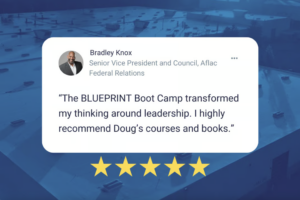At ConantLeadership, we’re committed to lifelong learning and continuous improvement. In service to your leadership growth, each month we curate the Leadership That Works Newsletter, a digest of timely resources from around the web. We prepare this resource in order to:
- Share actionable advice from top leadership luminaries
- Celebrate a range of viewpoints (inclusion is not an endorsement)
- Contextualize workplace trends through a leadership lens
- Illuminate cultural recalibrations in the world of work
- Support your personal development in life, leadership, and beyond
In this month’s Leadership That Works Newsletter: 5 ways to get unstuck, 9 workplace trends to watch this year, an assessment for employee engagement, a breakdown of ‘psychological contracts,’ ‘brainwriting,’ and more. As always, we’re sharing the content from our newsletter here on our blog in case you’re not subscribed to our mailing list. If you find these links enriching, you can sign up to receive our newsletter right here.
9 Workplace Trends to Watch This Year
In last month’s end-of-year newsletter we compiled the best leadership advice for 2024 from around the web. Building on those insights, Gartner researchers have identified nine key workplace trends to watch this year, covered in this Harvard Business Review piece. The authors say that the disruption that defined 2023, “from inflation to geopolitical turmoil to controversy over DEI and return-to-work policies,” will continue to shape our world and that leaders who “successfully navigate” and anticipate the following predictions “will retain top talent and secure a competitive advantage.”
The nine trends are:
Explore each of the nine key trends in greater depth in the full story here.
Are Your Employees Disengaged?
Research covered in this recent McKinsey article shows that “more than half of employees say they’re disengaged at work,” which means they report being “relatively dissatisfied with their jobs.” The findings are concerning considering that the same research shows that engaged employees contribute to “healthier workplaces and more consistent organizational performance.” While there are a variety of tools and assessments available to managers who want to improve employee engagement, leaders can start with this short, five-question quiz that assesses where team members fall on a “satisfaction spectrum.” Once you have a greater understanding of where people fit among “six archetypes” of job satisfaction—from “quitters” and “disruptors” on the low-engagement side, to “reliable and committed” and “thriving stars” on the high-engagement side—you will be well positioned to spark conversations and “spur actions to improve engagement.” Find the research and the five-question assessment in the full story here.
5 Ways to Get Unstuck
In this New York Times coverage of how to achieve breakthrough even after “feeling stuck,” experts offer five research-backed tips for pushing through resistance. First, it’s important to understand that “falling into a rut or feeling stagnant from time to time is a universal experience,” and that it is normal to “hit a plateau” during the pursuit of long-term goals. Luckily, researchers have discovered practical ways to jumpstart progress again.
Five ways to get unstuck are:
- Do a ‘friction audit‘: Ask yourself questions to identify “the things that create obstacles and add complications or stress” that interfere with your goals.
- Reframe negative thoughts: Don’t accept harsh self-talk. “For example, instead of ‘I’m going to fail at this project,’ you can think, ‘I’m going to do the best I can, and if I’m struggling I will ask for help.'”
- Try ‘futurecasting‘: Practice envisioning your ideal set of circumstances, “a future life where you are unstuck,” and “then think about the specific steps that would help you work toward that vision.”
- Share your goal: “Just the force of putting the words into the world now makes you believe—makes you commit.”
- Do something meaningful: “Spending time on activities that align with your values” can give you energy and propel you forward. In fact, “we need meaning more than ever when we’re feeling stuck.”
Get the full story here.
Understanding the ‘Introvert Economy’
“During the pandemic, a lot of Americans had to stay home—and many discovered that they preferred staying in to going out,” writes Allison Schrager in this Bloomberg column on an emerging post-pandemic phenomenon that she calls the “Introvert Economy.” In the “Introvert Economy,” consumers are venturing outside less and choosing homebody activities more. Although Schrager notes that “many things are getting back to normal,” it’s important to remember how “the pandemic profoundly changed American life,” largely by habituating people to working, socializing, and shopping from the comfort of their private spaces. And studies show that this introversion boon may continue. Research finds that younger generations, once the exemplars of busy social calendars and late nights, are “going out less, and when they do go out, it is earlier.” If the trend holds, Schrager says there will be “winners and losers”: For example, the market will be great for comfortable “athleisure wear,” but restaurateurs and bar managers “might have to find more creative ways to earn a profit.” Get the full story here.
What’s Your Org’s ‘Psychological Contract’?
Employment contracts are a standard part of starting a new job at most companies, but “there’s another undefined list of terms” that new-hires are a tacitly accepting, says this Worklife post on the topic of psychological contracts. A “psychological contract,” unlike the more straightforward terms of an offer letter, is “an unspoken agreement between employees and employers addressing what they owe each other.” These mutual expectations tend to go deeper than the contractual nuts-and-bolts of job roles, compensation, and benefits, and extend to the interpersonal values of the organization. Experts say psychological contracts are honored “when both sides think it’s a fair and equal deal,” and share a belief that all parties are committed to treating one another well. These contracts work best “with strong cultures focused on collaboration, as opposed to competition,” and are maintained through consistency from leaders e.g., “what you say and what you do absolutely need to match.” Maintaining the understanding between parties often comes down to trust and respect. Get the full story here.
Maybe We’ve Reached Peak Optimization
“Today’s workplace—and the world in general— is all about optimization,” writes Julie Winkle Giulioni in this counterintuitive SmartBrief piece about pursuing “sub-optimization” instead of hustling to maximize every waking moment. Giulioni observes that the proliferation of “tools and technology” that were ostensibly supposed to make our lives easier by streamlining tasks have not lived up to their promise of “lightening our loads.” In fact, the convenience and availability of optimization apps and software have pushed us “to take on ever more daunting levels of productivity” which can cause mental exhaustion. While she admits that “the drive to optimize all things—gifts, strengths, opportunities, time, assets—has been baked into our DNA,” there is a cost: “The casualties of this level of drive include joy, serendipity and sustainable energy levels.” And Giulioni warns that leaders who “engage in this sort of continuous, over-the-top optimization” end up incurring a tax of missed opportunities for innovation, connection, and inspiration.
So what’s the solution? She says leaders should embrace “strategic sub-optimization,” which chiefly involves “making space” for the unexpected and “freeing up time for what’s not scheduled.” Sub-optimization also nudges us toward internal mindset adjustments: “It requires a quieter and more attentive mind,” and involves “looking at the world with less judgment and more wonder.” And most of all, it asks leaders to move “beyond busyness to wholeness as the yardstick for effective and hard work.” Get the full story here.
The Leaders Who Refuse to Retire
As the human lifespan gets longer and longer, some professionals are eschewing a traditional career trajectory, which culminates in retirement, in favor of remaining employed well into their twilight years. In this column in The Economist, the Bartleby columnist makes the case for forgoing retirement altogether: “To step down means to leave center stage—leisure gives you all the time in the world but tends to marginalize you as you are no longer in the game.” While some folks may not be able to retire due to financial necessity, there are others who simply relish their vocation and for them, the columnist asks, “can anything truly replace the framework and buzz of being part of the action?” Even for the more relaxation-inclined who may not want to continue working, there are compelling reasons to find other ways to pursue one’s purpose and keep busy throughout life as “intellectual stimulation tends to keep depression and cognitive impairment at bay.” Most importantly, “there is depth in being useful,” and “excitement, even in significantly lower doses that are typical earlier in a career, can act as an anti-aging serum.” Get the full story here.
Ready for a Career Change? Try ‘Brainwriting’
“65% of American workers are actively searching for a new full-time job,” and if that job search also involves a career change, it will require “planning, researching, and taking risks,” writes Cheryl Robinson in this new Forbes piece. To meet the challenge of a new chapter in your working life, Robinson recommends the practice of “brainwriting.” She explains that brainwriting, which was first conceived as “a collaborative ideation practice,” for team problem solving, can also be a powerful technique for individuals because it “provides structure to the ideation process, making it easier to manage and analyze the generated ideas.” For groups, brainwriting consists of a “6-3-5” concept in which “six people identify a problem statement,” and then they each “generate three ideas in five minutes.” To adapt the modality for individuals, Robinson says to “clearly articulate the specific challenge or question related to your career strategy that you want to address.” Then, “draw out a diagram with six columns and three rows,” and “in each column, write down a new position or industry that excites you.” In each row, “write down a top skillset you will need to thrive in that position or industry.” Make the exercise time sensitive, giving yourself “no more than five minutes for each column,” to prevent “overthinking or talking yourself out of a particular position due to impostor syndrome.” Get the full story, including a visual example of the brainwriting diagram, here.
Insights & Resources from ConantLeadership
December’s Leadership That Works Newsletter
 A Proven Process for Transforming Your Leadership
A Proven Process for Transforming Your Leadership
Discover the same six-step Blueprint process that Doug used to change his life—from getting fired to ascending to the C-suite, CEO, and chairman ranks at three iconic Fortune 500 companies.
>> Learn more.
 About the Author: Amy Federman is ConantLeadership’s Director of Content and Editor in Chief, and co-author with Doug Conant of the WSJ bestseller, The Blueprint.
About the Author: Amy Federman is ConantLeadership’s Director of Content and Editor in Chief, and co-author with Doug Conant of the WSJ bestseller, The Blueprint.
(Cover photo by Ondrej Supitar on Unsplash)






0 Comments